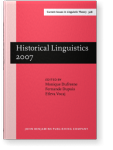Le changement linguistique dans la langue orale selon deux recherches sur le terrain séparées d’un siècle
This article compares the linguistic change produced during the twentieth century in ten features of verbal morphology in the north-eastern part of Catalonia, to the south of the Pyrenees. For the start of the twentieth century, we examine Alcover’s oral corpus (1906–1928) and, for the end of the century, we examine the data compiled from a field research project performed between 1999 and 2000. The features are classified into two spatial geographical types. The first comprises those performed more frequently in Roussillon (French Catalonia), and less frequently south of the state border: 1. Morph of the person-number = /i/ in the 1st person singular of the present indicative (e.g. canti) in verbs of classes i, ii and iii; 2. Morph of mood-tense = /a/ (= [e]) in the 2nd person singular of the present indicative in verbs of classes II and III (e.g. dormes); 3. Lack of thematic vowel in the infinitive and thematic vowel /í/ in the rest of the tenses (e.g. fúger ~ fugim); 4. Lack of velar extension in the 1st person singular of the present indicative of the verb ‘ser’ (som); 5. Epithesis [e] to the infinitive of monosyllabic verbs (e.g. dire). The second comprises features found in an area corresponding roughly to the diocese of Girona, located south of the state border: 6. Addition of /z/ to the morph /m/ of the 1st person plural of the present indicative of the verb ser (and diffusion to other persons, tenses and verbs) (e.g. soms); 7. Epithesis [k]/[t] in the 1st person singular of the present indicative (e.g. cantoc, cantot); 8. Posterior epenthesis in the morph /./ of the infinitive (e.g. néix(e)re: /néʃr/ + [e] ); 9. End of the lexical root in non-etymological /b/ for verbs in the subgroup [-w] of the verbal subclass [II, +ext.] (e.g. crevies); 10. Velar extension in the 1st and 2nd persons plural of the present indicative of verbs in the verbal subclass [II, +ext.] (e.g. creguem). These two types of feature intersect in the diocese of Girona. This study focuses on the northern part of the Girona area. In general, we find differences in the behaviour of the two groups in terms of their linguistic development during the twentieth century. At the start of the twentieth century the overall level of production of type I features in each place was generally lower than that of type II features. In addition, the presence of alternative forms originally from central Catalan (variety located to the south of the diocese and which coincides to a large extent with standard Catalan) can be clearly seen in type I features. Over the twentieth century, the fall in the production of type I features considered as a whole is particularly notable. This is not the case, however, of type II features: the current data show that they are still quite widely used. The data suggest that the type to which the features belong — defined by their spread throughout the geographical area from the place where they are most used — may be responsible, at least in part, for the differences in their behaviour with regard to the linguistic change that occurred over the course of the twentieth century.
